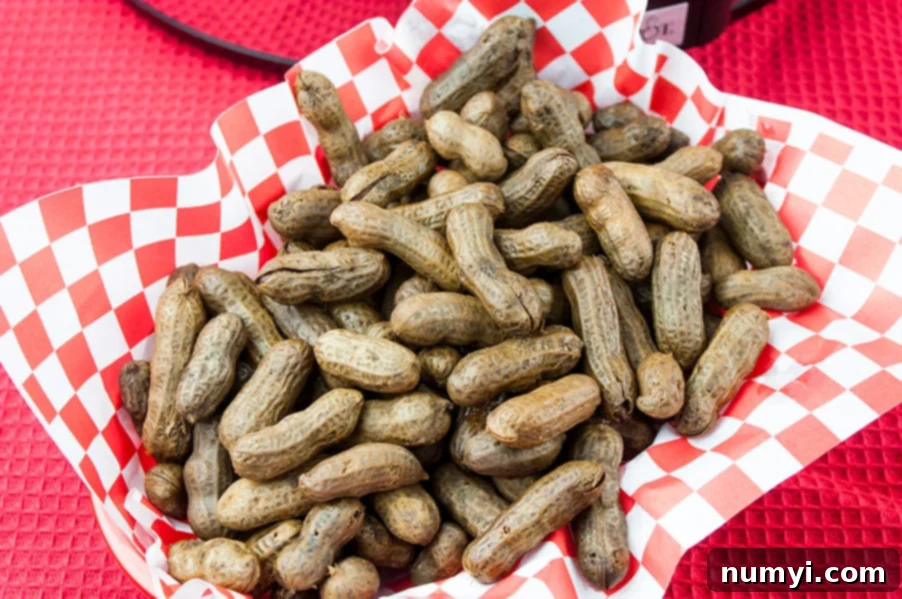The Easiest Way to Make Perfect Slow Cooker Boiled Peanuts: A Southern Delicacy at Home
Craving a taste of the South without the fuss? Our recipe for **slow cooker boiled peanuts** is your ticket to a warm, salty, and wonderfully tender snack that’s surprisingly easy to prepare. This classic Southern treat is a culinary experience unto itself, offering a unique texture and savory flavor that perfectly satisfies. Whether you’re a long-time aficionado or new to the world of boiled peanuts, the slow cooker method simplifies the process, ensuring consistently delicious results with minimal effort.
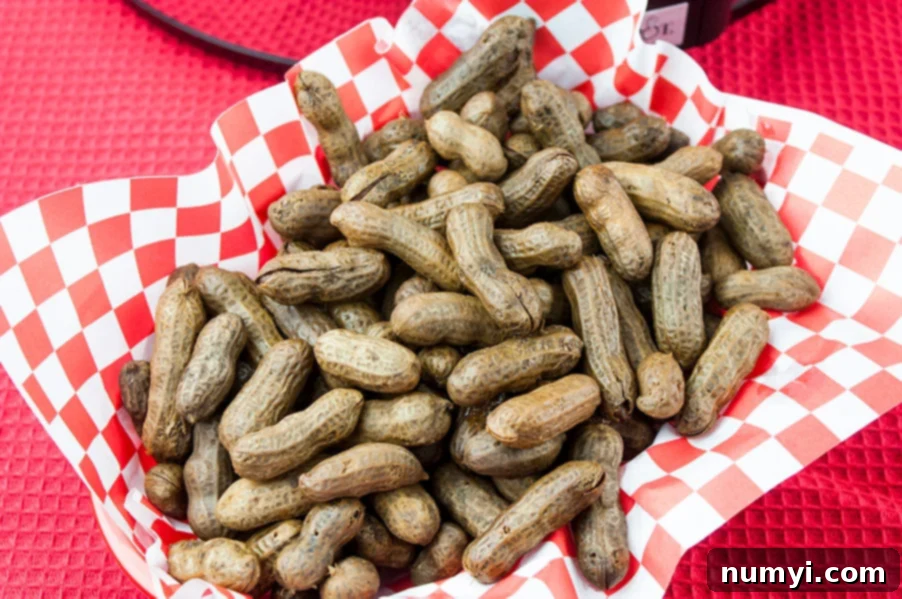
Boiled peanuts hold a special place in Southern cuisine, often found simmering at roadside stands, sporting events, and family gatherings across states like Georgia, Florida, and the Carolinas. This iconic snack is distinct from roasted peanuts, boasting a softer, bean-like texture that melts in your mouth, infused with salty, savory, or even spicy notes. It’s a taste that evokes nostalgia for many, a true comfort food that embodies the region’s culinary heritage. While some might find the texture unexpected, fans of boiled peanuts can attest to their irresistible charm and addictive quality.
It’s true, boiled peanuts are often a “love-it-or-leave-it” kind of food. For those of us who adore them, they’re an ultimate indulgence. My family, for example, is divided: my daughter and I can’t get enough of these flavorful legumes, happily cracking open shell after shell. My husband, on the other hand, prefers his peanuts roasted and crunchy, steering clear of anything “boiled.” And that’s perfectly fine! The beauty of food, and especially traditional snacks like these, is in the diversity of tastes and preferences. For everyone who shares our love for these tender, briny delights, this slow cooker method is a game-changer.
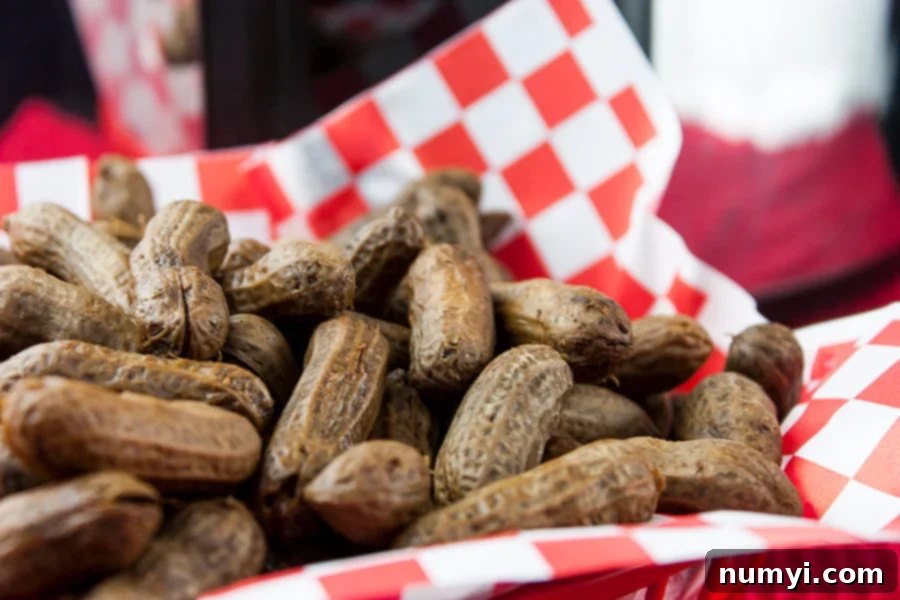
Why You’ll Fall in Love with Slow Cooker Boiled Peanuts
Forget the days of constantly monitoring a large pot on the stovetop! Making **crock pot boiled peanuts** is a game-changer, offering a truly hands-off and effortless approach to this Southern staple. This method not only simplifies the cooking process but also delivers consistently perfect results every time. Here’s why you’re going to absolutely adore this recipe:
- Effortless Cooking: The slow cooker does all the hard work for you. Simply combine the ingredients, set it, and forget it for several hours. No constant stirring, no worrying about boiling over, and no need to hover over the stove.
- Perfect Texture Every Time: The low and slow cooking environment of a slow cooker ensures that your raw peanuts transform into incredibly tender, soft, and moist legumes, perfectly infused with flavor. They achieve that ideal “bean-like” consistency that distinguishes truly great boiled peanuts.
- Ideal for Entertaining: Planning a party or a casual get-together? These **warm, salty, tender boiled peanuts** are the ultimate crowd-pleasing snack. Once cooked, you can simply switch your slow cooker to the “warm” setting, allowing guests to enjoy hot, delicious peanuts throughout the event without any additional effort on your part. It’s perfect for tailgates, BBQs, or just a cozy evening with friends and family.
- Customizable Flavor Profile: While our recipe features a classic Creole seasoning blend, the slow cooker method easily accommodates a wide array of flavors. You can adjust the saltiness, add a spicy kick, or experiment with various herbs and spices to create your signature batch.
- Budget-Friendly Snack: Raw peanuts are an economical ingredient, making boiled peanuts a delicious and affordable snack option for individuals and families alike.
Embrace the simplicity and deliciousness of slow cooker boiled peanuts – they truly are the perfect snack for any occasion, from a quiet afternoon craving to a lively gathering!
Essential Ingredients for Perfect Boiled Peanuts
Creating the ultimate batch of slow cooker boiled peanuts requires just a few simple, yet crucial, ingredients. The quality and type of these components will significantly impact the final flavor and texture of your snack. Here’s a closer look at what you’ll need:
- Peanuts – The foundation of any great boiled peanut recipe is the right type of peanut. You absolutely must use **raw, in-the-shell peanuts** for this recipe. Unlike roasted peanuts, raw peanuts still contain their natural moisture, which allows them to absorb water and seasonings during the long cooking process, resulting in that signature tender, creamy texture. You have a couple of options here:
- Green Peanuts: These are freshly harvested, raw, “wet” peanuts that haven’t been dried. They are typically available during late summer and fall in Southern states. Green peanuts cook faster and yield an exceptionally tender and flavorful result. If you can find them, they are highly recommended for the best boiled peanuts.
- Regular Raw Peanuts (Dried): If green peanuts aren’t available, standard raw, in-the-shell peanuts (often found in the produce or bulk section of grocery stores) will work wonderfully. However, since these have been dried, they will require a bit more preparation. It is essential to **soak dried raw peanuts overnight** (8-12 hours) in cool water before cooking. This rehydrates them, allowing them to soften properly during the slow cooking process and significantly reducing overall cooking time. Skipping this step for dried peanuts will result in them remaining hard even after extended cooking.
- Seasonings – The flavor profile of your boiled peanuts can be as simple or as complex as you desire. Our recipe provides a fantastic starting point:
- Salt: A generous amount of salt is non-negotiable for authentic boiled peanuts. We recommend **kosher salt** for its clean flavor and larger crystals, which dissolve nicely over time. The salt permeates the peanut shells and meat, providing that essential briny taste. Adjust the amount to your personal preference – some like them extra salty, others prefer a milder brine.
- Creole Seasoning: This recipe leans into a **Cajun boiled peanuts** style by incorporating Creole seasoning. This blend typically includes salt, red pepper, black pepper, garlic, and onion powder, offering a vibrant, savory, and slightly spicy kick. If you prefer a simpler, classic taste, you can certainly omit the Creole seasoning and rely solely on salt. In that case, you would likely want to increase the amount of kosher salt to ensure the peanuts are adequately seasoned.
- Water – Sufficient water is critical to ensure the peanuts are fully submerged throughout the long cooking process. You’ll need enough to cover the peanuts by several inches, as they will absorb a considerable amount of liquid.
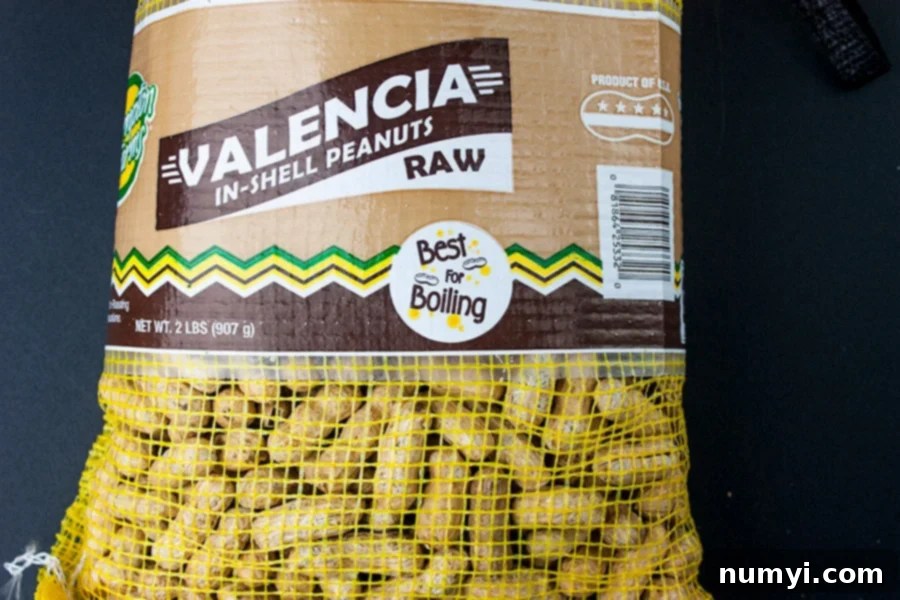
With these key ingredients in hand, you’re well on your way to enjoying a delicious batch of homemade slow cooker boiled peanuts!
Expert Tips & Exciting Flavor Variations for Boiled Peanuts
While making slow cooker boiled peanuts is inherently straightforward, a few key tips and creative variations can elevate your batch from good to unforgettable. Follow these recommendations to ensure the best results and explore new flavor dimensions:
- Simplify Cleanup with a Slow Cooker Liner: Boiled peanuts can sometimes leave a starchy residue in your slow cooker. To make cleanup a breeze, consider using a slow cooker liner. It’s a small step that saves a lot of scrubbing, allowing you to enjoy your snack without the post-cooking chore.
- The Golden Rule: Always Use Raw Peanuts: This cannot be stressed enough – this recipe explicitly calls for **raw, in-the-shell peanuts**. Roasted, shelled, or blanched peanuts will not yield the desired soft, bean-like texture. If you’re using raw dried peanuts, it is absolutely crucial to **soak them overnight (for at least 8-12 hours)** in cool water before adding them to your slow cooker. This rehydrates the peanuts, ensuring they soften properly during the slow cooking process and significantly reduces the required cooking time. Without soaking, dried peanuts will remain hard and chewy, even after prolonged cooking.
- Master the Art of Seasoning – And Dare to Experiment: The beauty of boiled peanuts lies in their versatility. Our recipe offers a delicious starting point with salt and Creole seasoning, but don’t hesitate to customize the flavor to your liking:
- Classic Salty: If you prefer the traditional, purely salty taste, simply omit the Creole seasoning and increase the amount of kosher salt until it reaches your desired brine level.
- Spicy Kick: For those who love heat, introduce **Old Bay seasoning, crab boil seasoning, a generous splash of your favorite hot sauce, fresh or dried chopped jalapenos, or red pepper flakes.** You can even add a few dashes of Tabasco or Frank’s RedHot to the cooking water for a fiery twist.
- Garlicky Goodness: Incorporate several cloves of minced garlic or a few tablespoons of garlic powder for a pungent, savory depth.
- Herbal Infusion: Experiment with bay leaves, sprigs of fresh rosemary, or a touch of smoked paprika for a more complex aroma and taste.
- Tangy Twist: A squeeze of lime or lemon juice after cooking can add a refreshing zest.
- Maintain Optimal Water Levels: Throughout the long cooking process, your peanuts will absorb water, and some will evaporate. It’s vital to **periodically check the water level** in your slow cooker to ensure the peanuts remain fully submerged. If the water level drops too low, add more hot water to cover them by at least an inch or two. This ensures even cooking and proper hydration.
- Patience is Key for Tenderness: Boiled peanuts require time to reach that perfect, soft texture. Resist the urge to rush the process. Cook on the “low” setting for the recommended duration, and then check for tenderness. If they’re still firm, simply continue cooking until they reach your desired softness.
- Taste Test for Saltiness: As the peanuts cook and absorb the brine, their saltiness will develop. After about 12-16 hours of cooking, you can remove a peanut, crack it open, and taste it to assess the salt level. If it’s not salty enough, you can add a bit more salt to the cooking water.
- Cooling and Draining: Once cooked to perfection, drain the peanuts immediately. Allowing them to sit in the cooking liquid for too long after the heat is off can make them overly salty or mushy.
By keeping these tips in mind and feeling adventurous with your seasoning choices, you’ll consistently make amazing slow cooker boiled peanuts that everyone will rave about!
Don’t Sweat The Recipe is supported by its readers. We may earn a commission if you purchase through a link on our site. Learn more.
Step-by-Step Guide: How to Make Irresistible Slow Cooker Boiled Peanuts
Embarking on the journey of making your own boiled peanuts is incredibly rewarding, and the slow cooker method makes it exceptionally simple. Forget the traditional stovetop approach with its constant vigilance, massive pots, and endless boiling. Our slow cooker technique eliminates the need for gallons of water rapidly boiling, the incessant waiting for a boil, and the close supervision typically required. This truly is the easiest, most hands-off way to achieve perfectly tender, flavorful boiled peanuts.
- Prepare Your Peanuts: Begin by thoroughly rinsing your raw, in-the-shell peanuts under cold running water. This helps to remove any dirt or debris. Once rinsed, drain them well and transfer them directly into the crock of your slow cooker. If you are using dried raw peanuts, ensure you’ve soaked them overnight as per our tips above.
- Add Seasonings and Water: To the slow cooker containing your rinsed peanuts, add the kosher salt and Creole seasoning (or your preferred blend of spices). Pour in enough water to completely cover the peanuts. A good rule of thumb is to ensure the water level is at least 1-2 inches above the peanuts, as they will swell and absorb liquid during cooking.
- Stir and Set to Cook: Give all the ingredients a good stir to ensure the salt and seasoning are evenly distributed throughout the water and among the peanuts. Place the lid firmly on your slow cooker. Set your slow cooker to the **low** setting and allow it to cook for a minimum of 20 hours, and up to 24 hours. This extended cooking time is crucial for developing the characteristic tender texture and deep flavor. This is where the convenience of a programmable slow cooker truly shines, allowing you to set it and walk away without worry.
- Monitor Water Level: During the long cooking cycle, it’s a good practice to periodically check the water level. As steam escapes, the water might reduce. If you notice the peanuts are no longer fully submerged, simply add more hot water to keep them covered. This ensures they cook evenly and remain tender.
- Check for Tenderness: After approximately 20 hours of cooking, it’s time to test for doneness. Carefully remove one peanut, crack it open, and taste it. The peanut should be wonderfully soft, almost bean-like in texture, and fully seasoned. If they are still a bit firm or chewy, simply continue cooking for another 2-4 hours, or until they reach your desired level of tenderness. Some batches might require the full 24 hours (or even slightly more for very dry peanuts) to achieve perfect results.
- Drain and Serve: Once your peanuts have reached the ideal tenderness, carefully drain all the cooking liquid from the slow cooker and discard it. You can either serve them immediately while warm, or allow them to cool slightly.
- Enjoy! These simple yet incredibly tasty slow cooker boiled peanuts are now ready to be enjoyed! Grab a handful, crack them open, and savor the soft, salty, and savory goodness. They’re perfect as a snack, an appetizer, or a unique addition to any gathering.
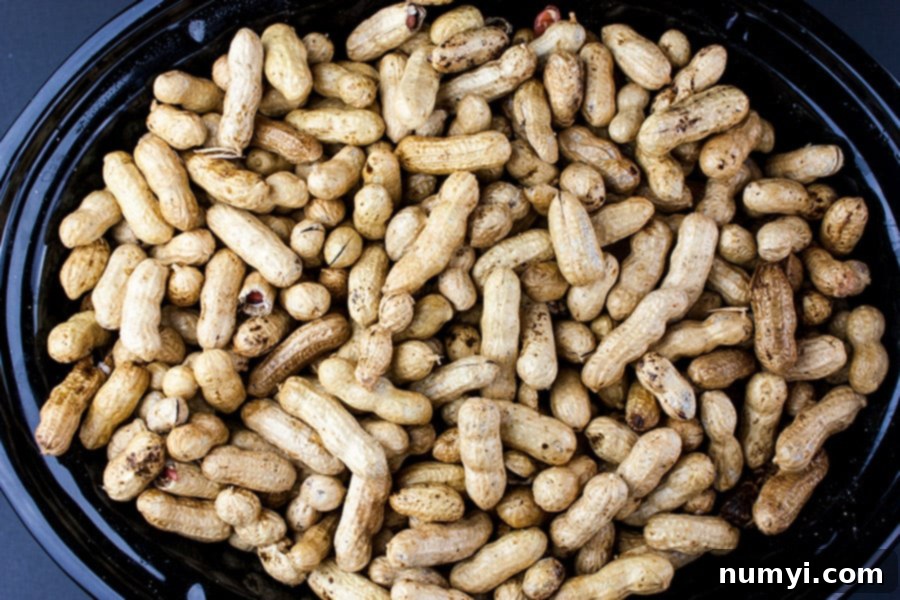
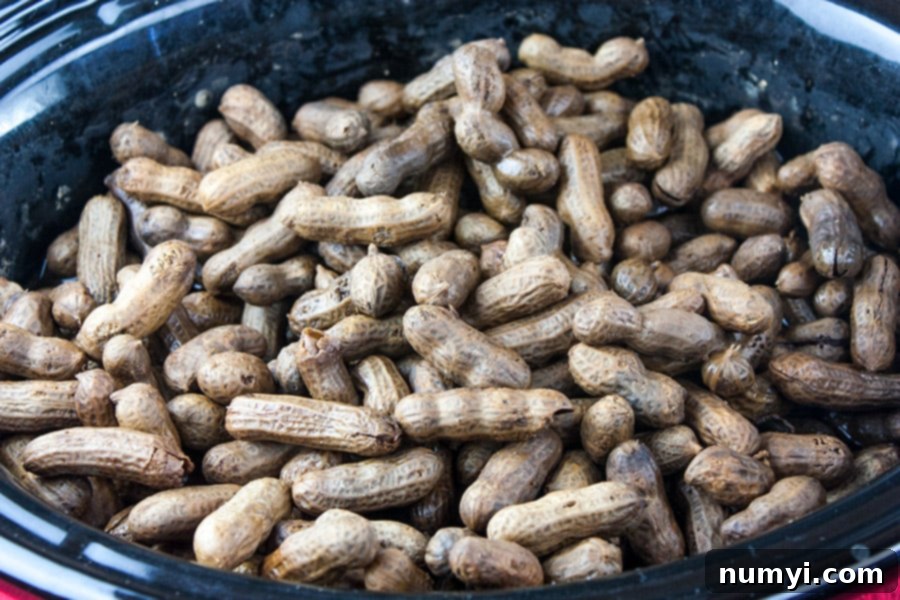


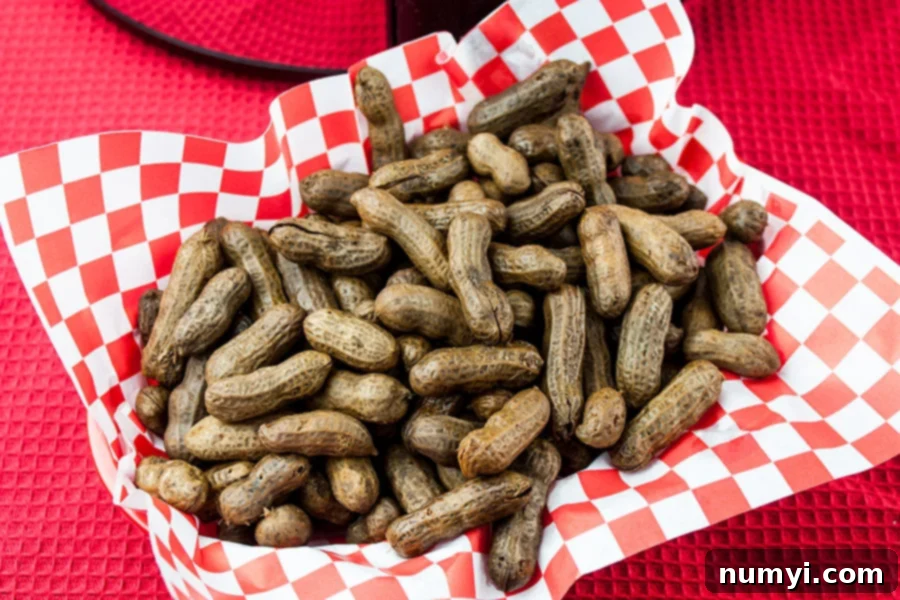
The Rich History and Cultural Significance of Boiled Peanuts
Boiled peanuts are more than just a snack; they are a deeply rooted culinary tradition, especially prominent in the Southern United States. Their history intertwines with agricultural practices, regional tastes, and a distinct way of life.
The tradition of boiling peanuts is believed to have originated in the coastal plain region of the American South, likely introduced by enslaved Africans who brought peanut cultivation and cooking techniques from their homelands. Peanuts, native to South America, found fertile ground and a welcoming climate in the Southern states, becoming a staple crop. Early recipes for boiled peanuts would have been simple, often using salt and water, reflecting a resourceful approach to food preparation.
Initially, boiled peanuts were a seasonal delicacy, enjoyed during the late summer and early fall harvest when “green” (freshly harvested, undried) peanuts were abundant. Farmers and their families would boil large batches, consuming them fresh and preserving some through various methods. Over time, this humble snack evolved into a beloved regional specialty, synonymous with Southern hospitality and casual outdoor gatherings.
Today, you’ll find boiled peanuts readily available at roadside stands, convenience stores, and farmers’ markets throughout states like Georgia, Florida, Alabama, and the Carolinas. For many Southerners, the scent of boiling peanuts is a familiar and comforting aroma, signaling lazy afternoons, beach trips, tailgates, and family road trips. They represent a connection to heritage, a taste of home, and a shared cultural experience. While often associated with simple seasoning, the evolution of regional flavors has led to spicy Cajun-style peanuts, garlicky infusions, and other creative variations, showcasing the snack’s enduring adaptability and appeal.
Nutritional Insights: Are Boiled Peanuts Healthy?
Beyond their delicious taste and comforting appeal, boiled peanuts also offer some noteworthy nutritional benefits, making them a more wholesome snack choice compared to many other options. As legumes, peanuts are naturally rich in:
- Protein: An excellent source of plant-based protein, contributing to satiety and muscle health.
- Healthy Fats: Primarily monounsaturated and polyunsaturated fats, which are beneficial for heart health.
- Fiber: Good for digestive health and helps in managing blood sugar levels.
- Vitamins and Minerals: Peanuts contain essential nutrients such as B vitamins (especially niacin and folate), magnesium, phosphorus, and potassium.
- Antioxidants: They are packed with various bioactive compounds, including resveratrol, which have antioxidant properties.
While the sodium content can be high depending on the amount of salt used, when enjoyed in moderation as part of a balanced diet, boiled peanuts offer a nutrient-dense and satisfying snack.
Creative Serving Suggestions for Your Boiled Peanuts
Boiled peanuts are fantastic on their own, straight from the shell, but their versatility allows for various serving opportunities. Here are some ideas to make the most of your delicious slow cooker batch:
- Classic Roadside Snack: Serve them warm in a small paper bag or a rustic basket lined with checkered paper, just like you’d find at a Southern roadside stand.
- Party Appetizer: Keep them warm in your slow cooker on the “warm” setting at gatherings. Provide small bowls for shells and napkins. They’re a unique conversation starter!
- Tailgate Favorite: Pack them in a thermos to keep them warm for sporting events or outdoor activities. They’re easy to eat and share.
- Beach or Picnic Treat: While typically served warm, boiled peanuts are also delicious chilled, making them a refreshing option for a beach day or picnic.
- Flavor Pairings: Their salty profile pairs wonderfully with cold beverages like iced tea, beer, or lemonade.
- Salad Topper (shelled): For an adventurous twist, shell the peanuts and add them to salads for a unique, tender texture and savory punch.
Troubleshooting Common Boiled Peanut Issues & FAQs
Even with a straightforward slow cooker method, you might encounter a few questions or minor hiccups. Here are some solutions and frequently asked questions to ensure your boiled peanuts turn out perfectly every time:
Common Troubleshooting
- Peanuts aren’t soft enough after 24 hours: This is almost always due to using dried raw peanuts without adequate pre-soaking. Ensure you soak dried peanuts overnight (8-12 hours) before cooking. If you didn’t, and they’re still hard, add more hot water and continue cooking on low. They will eventually soften, but it will take much longer. Another factor could be extremely fresh “green” peanuts which can sometimes take a bit longer than average to become perfectly tender.
- Peanuts are too salty: If you find your cooked peanuts overly salty, you can try rinsing them gently under cold water after draining, or briefly soaking them in fresh, unsalted water for 15-30 minutes, then draining again. In the future, reduce the amount of salt in the cooking brine.
- Peanuts aren’t salty enough: Taste test around the 12-16 hour mark. If they need more salt, stir in an additional tablespoon or two of kosher salt into the cooking water and continue cooking. The longer they sit in the brine, the more flavor they absorb.
- Water evaporated too quickly: This can happen with older slow cookers or if the lid isn’t sealed tightly. Ensure you check the water level periodically and top it off with hot water as needed to keep the peanuts fully submerged.
Soaking the peanuts ensures they will soften while cooking, especially crucial for dried raw peanuts as it rehydrates them for optimal texture. Skipping this step can lead to hard or chewy peanuts, even after extended cooking times.
That’s a personal preference. Typically, they are served warm, as this enhances their savory aroma and tender texture. However, they can absolutely be enjoyed cold, making them a refreshing snack on a hot day or a convenient option for packed lunches.
To maintain freshness and flavor, store cooked boiled peanuts in an air-tight container in the refrigerator for up to 1 week. For longer storage, they can be frozen for several months. Just be sure they last that long – they’re usually too delicious to keep around for long!
How to Store and Reheat Boiled Peanuts
Proper storage is essential to enjoy your delicious slow cooker boiled peanuts for days to come. Once cooled, transfer them to an airtight container and store them in the refrigerator. They will remain fresh and flavorful for up to 7 days. If you’ve made a large batch, you can also freeze them in freezer-safe bags or containers for several months. Simply thaw them in the refrigerator overnight when ready to enjoy.
To reheat, you have a few options:
- Slow Cooker: The best method for reheating a large batch, especially for entertaining. Add a little fresh water or broth to the slow cooker with the peanuts, and heat on low until warmed through.
- Stovetop: Place peanuts in a pot with a small amount of water. Heat gently over medium-low heat until warm, stirring occasionally.
- Microwave: For a small serving, place peanuts in a microwave-safe bowl with a splash of water, cover, and microwave in 30-60 second intervals until heated through.
Explore More Slow Cooker Delights
The slow cooker isn’t just for boiled peanuts! It’s an incredibly versatile kitchen appliance perfect for creating a wide variety of delicious, hands-off meals. If you’ve enjoyed the simplicity and flavor of this recipe, we encourage you to try some of our other favorite slow cooker recipes:
- Slow Cooker Roasted Chicken
- Slow Cooker Corned Beef
- Slow Cooker Lentil Soup Recipe
- Slow Cooker Pizza
- Slow Cooker Beef Stew
- Slow Cooker Mexican Chicken
- Slow Cooker Chex Mix
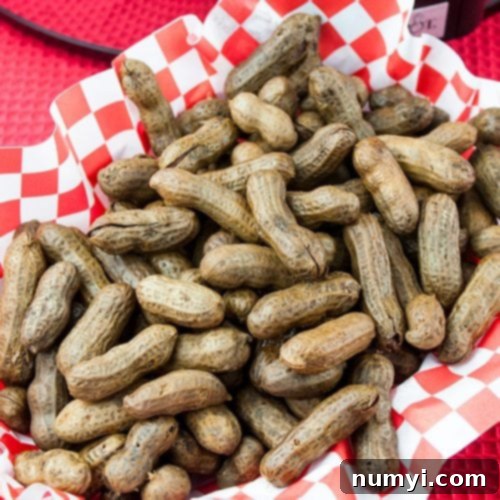
Slow Cooker Boiled Peanuts Recipe
Print
Pin
Rate
Ingredients
- 2 lbs raw green peanuts
- 1/3 cup kosher salt
- 1/4 cup Creole seasoning
- 10-12 cups water (enough to cover, add more if using dried peanuts that were soaked)
Instructions
-
Rinse raw peanuts thoroughly under cold water. If using dried raw peanuts, ensure they have been soaked overnight (8-12 hours) prior to this step. Drain the peanuts and place them into the crock of your slow cooker.
-
Add the kosher salt, Creole seasoning (if using), and enough water to cover the peanuts by 1-2 inches. Stir gently to combine all ingredients. Place the lid securely on the slow cooker and cook on the LOW setting for 20 to 24 hours. Remember to check water levels periodically and add more hot water if needed to keep peanuts submerged.
-
After 20 hours, test a peanut for desired tenderness. If not soft enough, continue cooking until they reach your preferred texture. Once cooked, carefully drain all the liquid from the peanuts and discard.
-
Serve warm immediately, or allow to cool before storing in an airtight container in the refrigerator for up to 1 week. Enjoy your homemade slow cooker boiled peanuts!
Notes
For an extra kick, consider adding about 1/3 cup of your favorite hot sauce or a few sliced jalapeños to the slow cooker along with the other ingredients.
The cooking time can vary based on the freshness of your raw peanuts and the specific slow cooker. Always test for tenderness as the ultimate guide.
